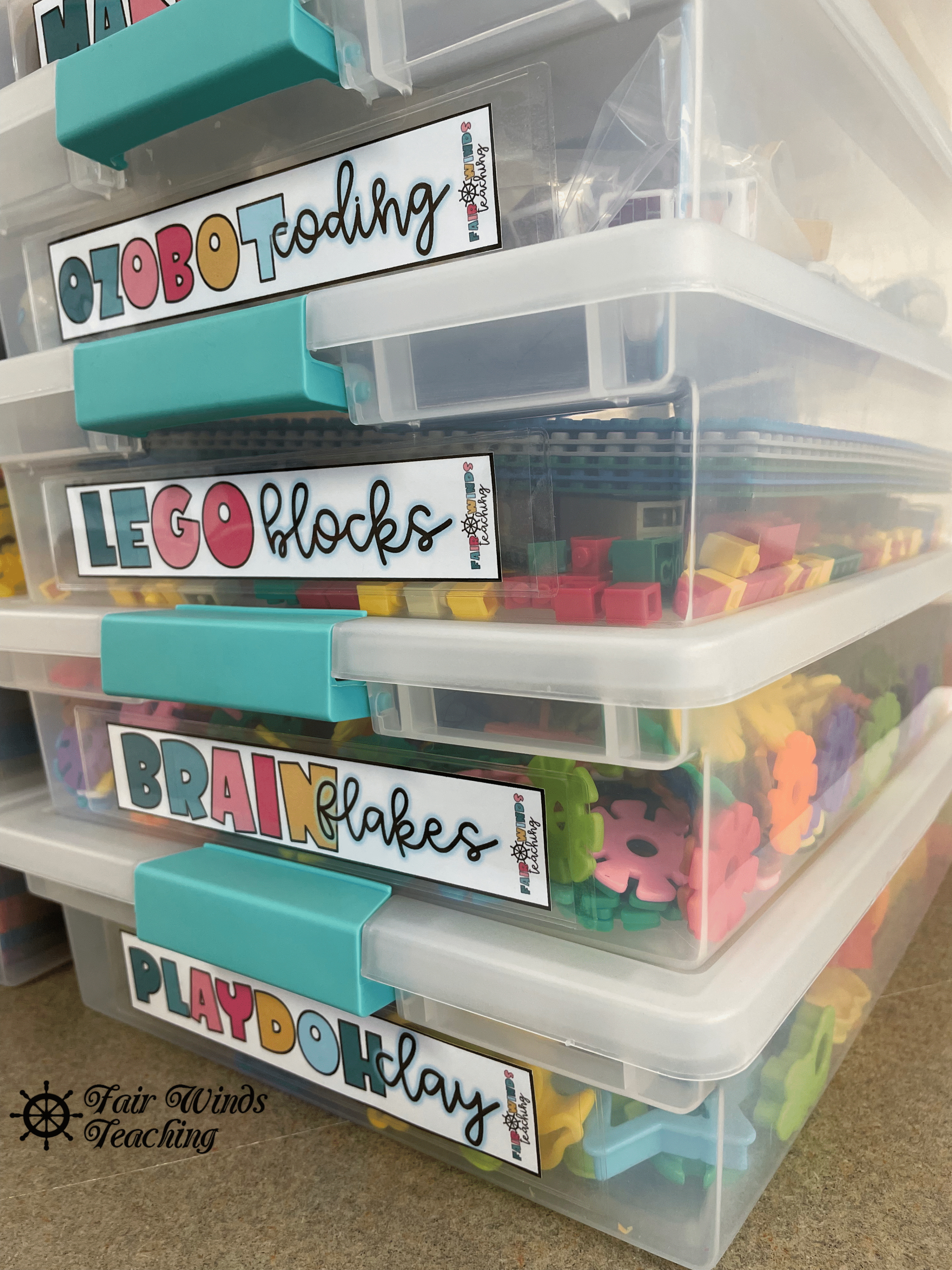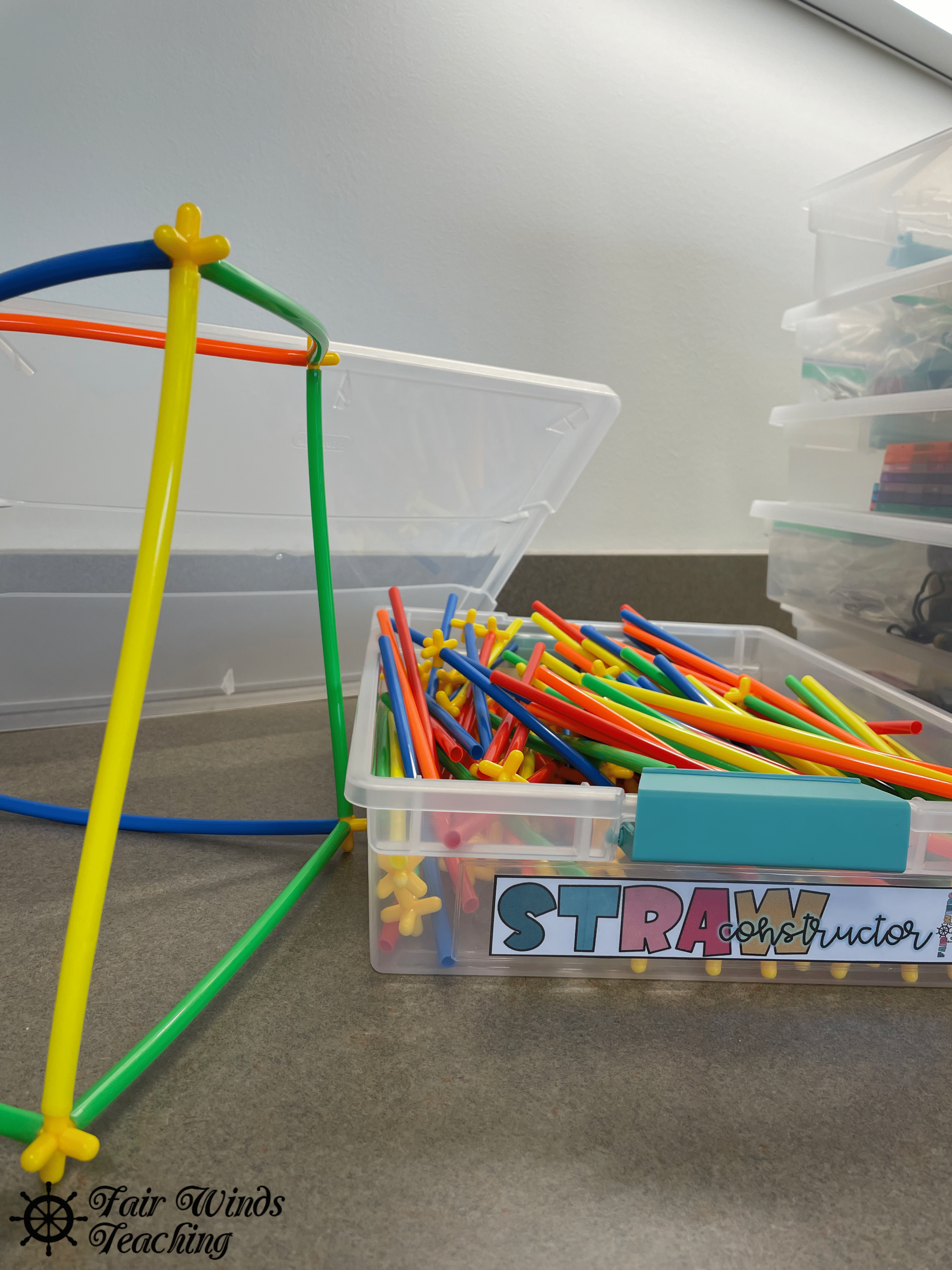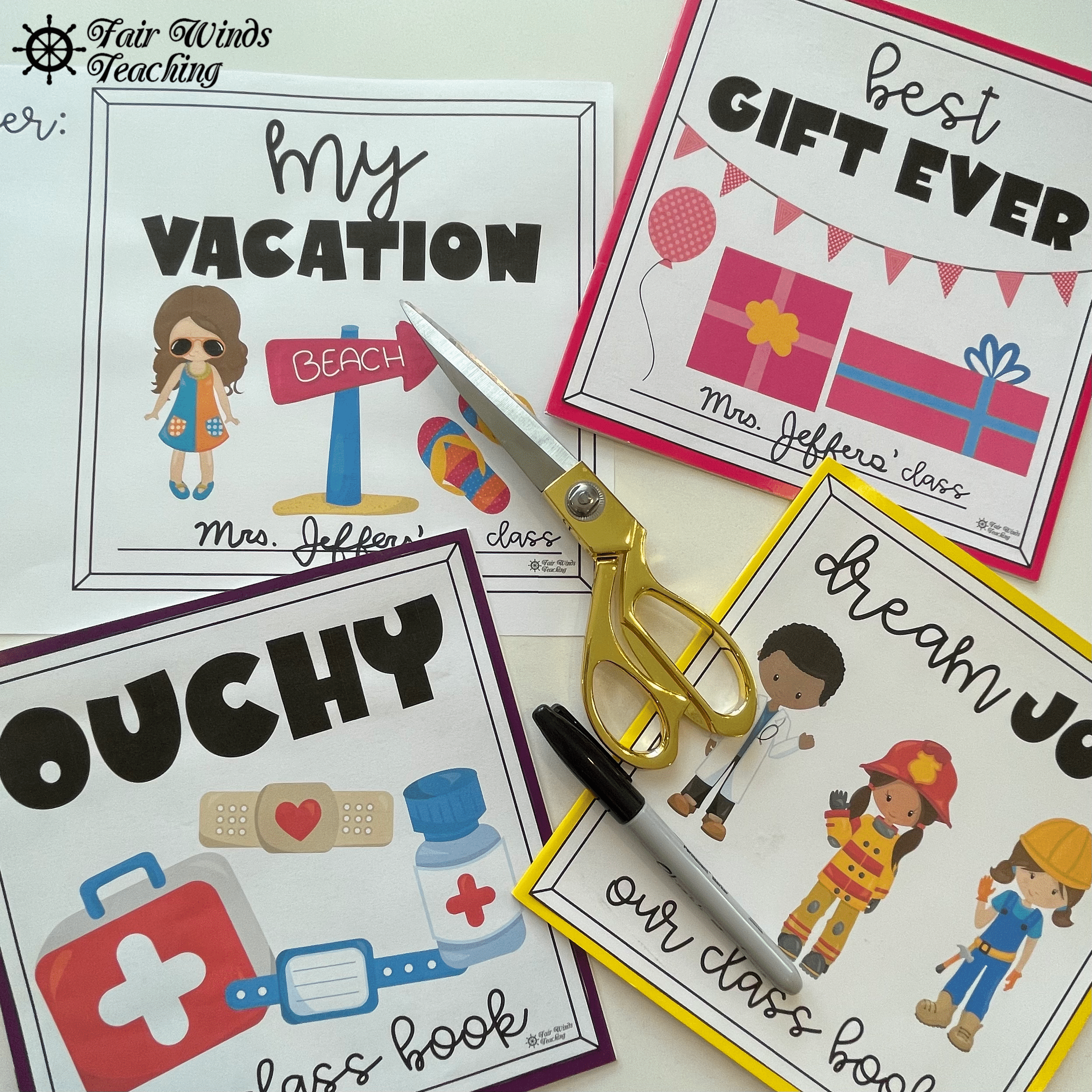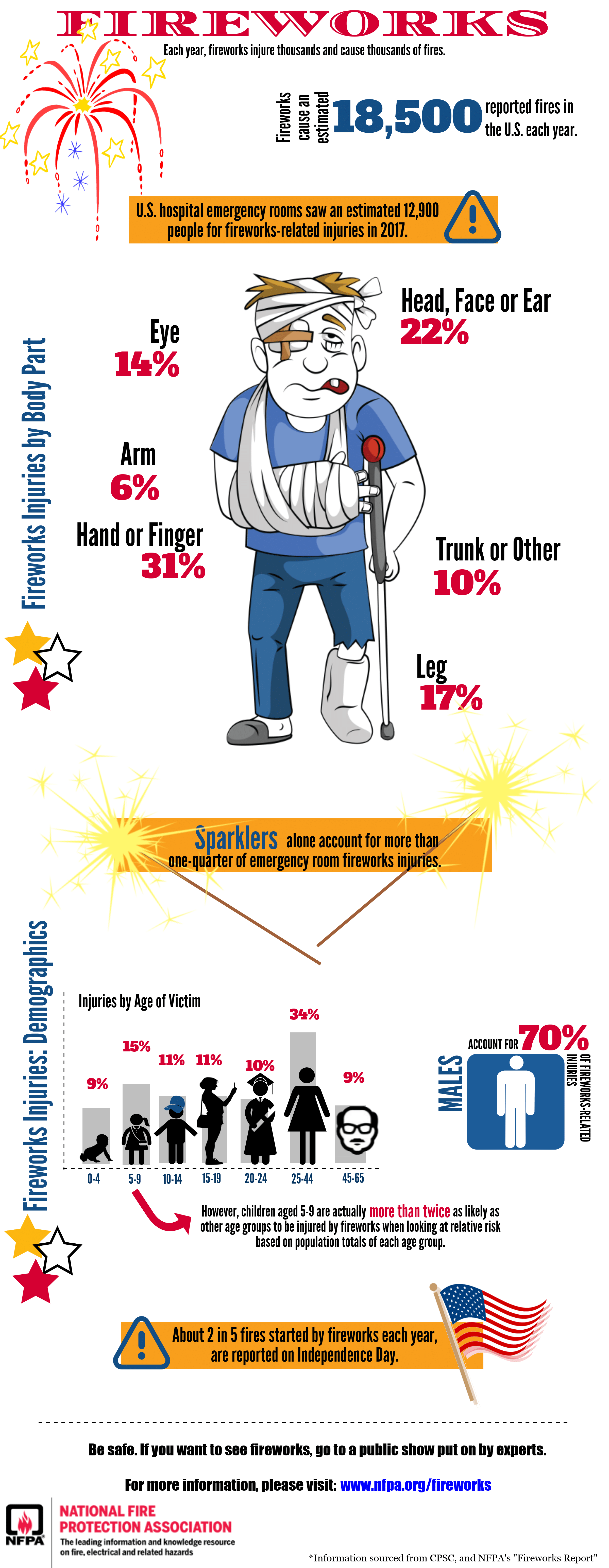by California Casualty | Auto Insurance Info |
We love—and need—our cars. So we should protect them to the fullest extent. July is National Vehicle Theft Protection Month and it’s the perfect time to take a look at whether we’re doing all we can to keep our cars safe.
Vehicle theft is more common than you think.
The pandemic has caused vehicle thefts to surge to the highest number in more than a decade. There were 873,000 vehicles stolen last year, up from an annual average of 750,000. A car is stolen in the U.S. every 36 seconds. As car prices rise and demand continues, we expect this trend to continue, too.
Don’t think it can happen to you? Think again- anyone can be a victim of vehicle theft. It takes less than 60 seconds for a thief to open your vehicle. They can use shaved or worn-down keys to jiggle the lock open. They can break the window or hotwire the car. For “keyless” vehicles, they use wireless transmitters to capture the signal from your key fob. They can also jam your signal as you’re locking your doors so that your vehicle doesn’t really lock.
How do you prevent vehicle theft?
Thieves are looking for an easy target. The harder you can make it for them, the less likely they are to target your car. Here are some ways you can prevent a break-in.
Anti-Theft Safety Devices
-
-
- Safety locks
- Steering wheel locks attach to the steering wheel to lock it in place.
- Tire locks attach to the outside of the tire, but are not easy to take on and off, so best for vehicles parked long-term.
- Hood locks vary by make and model so get one that fits yours exactly.
- Catalytic converter locks protect this car part that is often stolen.
- Car alarms usually require professional installation.
- GPS trackers are different than your GPS. They are specific devices to help the police find your car.
- Kill switches and engine immobilizers interrupt the ignition process. They change how your car operates so they’re not right for everyone.
Keyless Entry Safety
-
-
- Store the key fob in a signal-blocking box.
- Carry the fob in a shielded wallet or aluminum tin.
- Switch off your fob at night (if your key has this feature).
Other Steps You Can Take
-
-
- Etch your car’s VIN number on each window. Thieves often change the VIN to hide the identity of the car. They will not want to have to replace all the glass and may avoid your car as a result.
- Make sure your driveway is well lit.
- Trim shrubs and trees so you can clearly see your car from inside your house.
- Keep your vehicle doors locked when away from the car even for a minute.
- Close all windows, including the sunroof. Don’t leave your window cracked open even if it’s hot in the summer.
- Park in secure, well-lit areas.
- Don’t leave valuables in view. They could be tempting for a thief.
- Don’t leave your key in the car or your car running.
- Don’t keep your spare key hidden underneath your car. Thieves know where to look.
- Take your garage remote out of your car so thieves don’t have access to your house.
Remember, never leave any personal information in your car, such as a social security card, driver’s license, birth certificate, passport, or financial statement. Otherwise, you could be a victim of identity theft as well as vehicle theft.
Is your vehicle on the most stolen list?
Thieves prefer popular, high-performance cars, with interchangeable parts. They also like older cars, which typically do not have complex locks and security systems and can be sold for parts. Here are the latest statistics on the most common stolen vehicles in the U.S.:
- Honda Civic
- Honda Accord
- Ford Pickup
- Chevrolet Pickup
- Toyota Camry
- Nissan Altima
- Toyota Corolla
- GMC Pickup
- Dodge Pickup
- Jeep Cherokee/Grand Cherokee
Some regions are prone to car theft. Check your local statistics to see if yours is one.
What do you do if you are a victim of a theft?
Even if you take the proper precautions, thefts can still happen. If you are a victim of car theft, here are the steps to follow.
Step 1: Contact the police. Make sure that you have all of the information about your car, as they will need it. This includes the year, make, model, color, license plate number and vehicle identification number (VIN), any special markings (including dents). Write down the police report number; you will need it.
Step 2: Contact your insurance provider. You will need to provide them with the police report number and information about your vehicle. Your provider can tell you what your policy covers in the event of a theft.
Step 3: Arrange for transportation, such as a rental car. Note that rental car companies have a minimum age, usually 25. Some companies may offer rentals to younger drivers but at a higher cost.
Does insurance protect you if your vehicle is stolen?
If you have comprehensive auto insurance, you will be covered in case your car is stolen. Insurance will cover the cost of a replacement car, minus any deductibles or rental car costs that you may need to pay. Drivers who are paying loans on their vehicles are required to have comprehensive insurance. However, once you have paid off your car, this insurance is optional. Check with your insurer to see what is covered in the event of theft.
You can often save on your insurance premiums if you install anti-theft devices. Ask your provider for more information.
It typically takes 30 days before a vehicle is considered gone forever. Work with your insurance provider to get your claim paid, so you can get back on the road.
This article is furnished by California Casualty, providing auto and home insurance to educators, law enforcement officers, firefighters, and nurses. Get a quote at 1.866.704.8614 or www.calcas.com.

by California Casualty | Educators |
Written by Casey Keyser, MSEA Third Grade Teacher
You flip on your classroom lights, carry your 5 bags and 4 drinks in, drop everything down at your desk, turn on your computer, write your objectives, make copies and then it’s time to welcome in your students, and finally start your day- this is our everyday routine as educators.
For anyone that has ever taught in a classroom where you monitored your student’s arrival time, you know that keeping them occupied is critical when you still need to get all of your morning routines done. Pass out breakfast, take lunch orders, check your email, set up your centers, check communication folders, pull up a million websites, and start morning announcements.
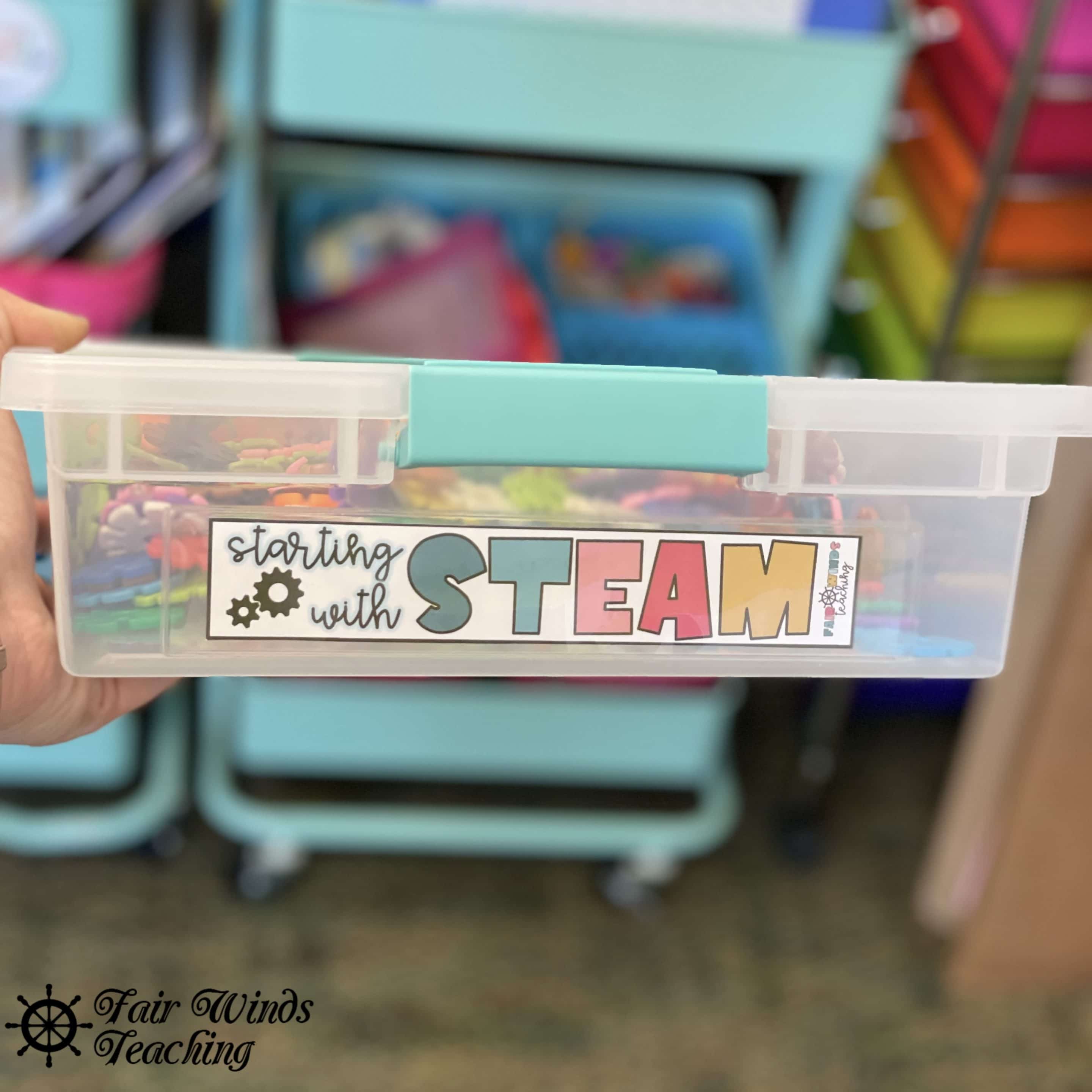
These 30 or so minutes are a perfect time to let your students get creative. A few years ago, I begin creating and using my, Starting with STEAM bins. These morning routine bins motivate my students get their breakfast eaten, complete their make-up work and set up for their day. They want to have time to explore and create with one of the Starting with STEAM bins.
These bins are designed to allow the students to have a creative mind and a bit of unstructured playtime. It awakens their brains for the day and lets them explore the world of science, technology, engineering, art, and mathematics (aka STEAM). Some of my bins come with prompts or directions but most of my bins are free-play or exploring materials.
Not only are they the perfect activity for the morning, but you could also incorporate these bins in lots of different situations; science centers, Genius Hour, Coding week, after-school programs, at home, “I’m done, now what” bins, and much more!
I started by buying 12 bins from Dollar Tree and they worked for a couple of years before they busted then upgraded to ones with lid locks on Amazon. You can find all of the supplies I bought on my Amazon Recommendation page here. Most of the items I fill my bins with are best to fit in a paper-sized bin or container.
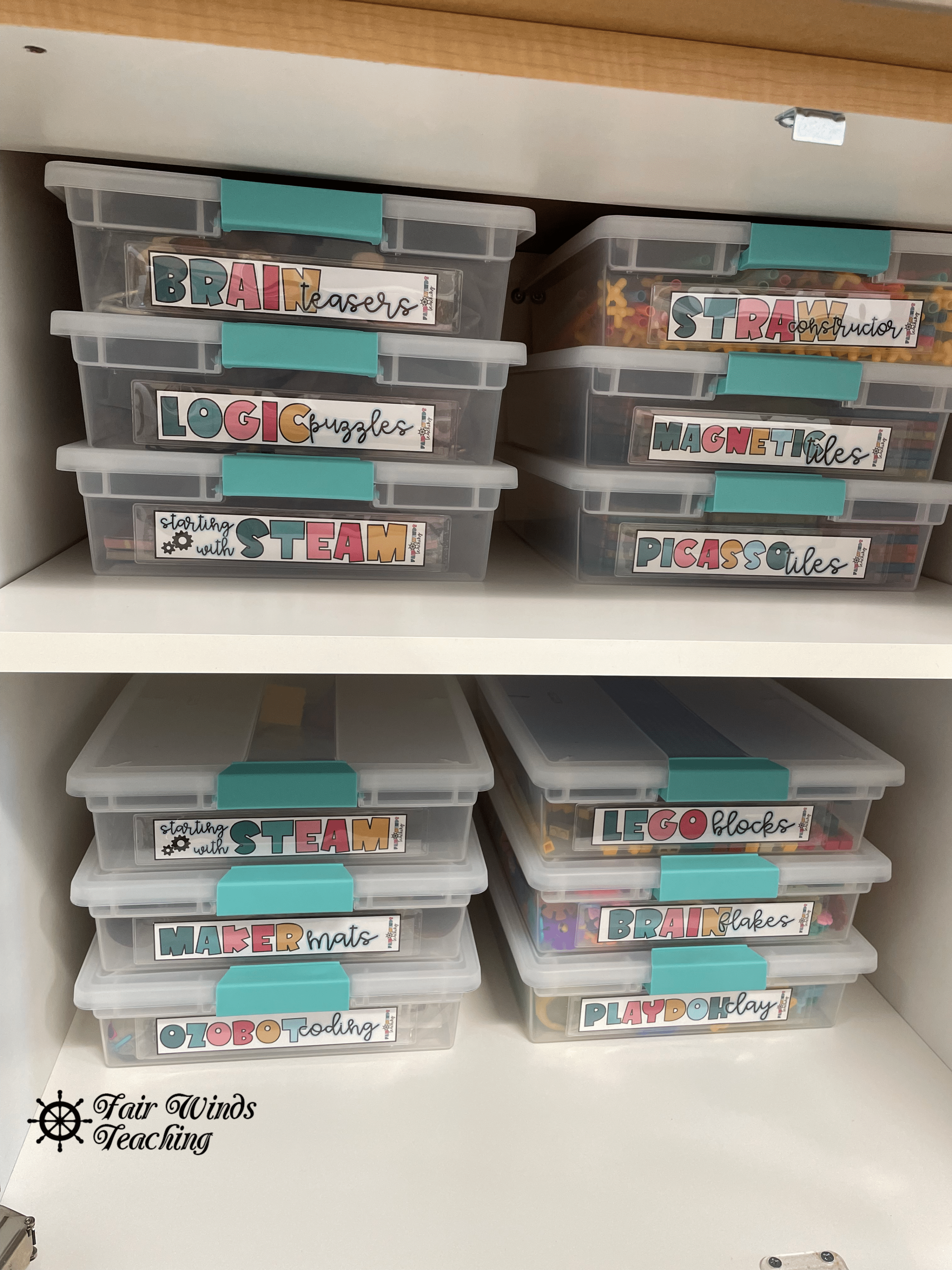
I then started collecting STEAM materials from anywhere I could find them. I always reach out to friends and family first to see if their children have grown out of their old toys such as magnetic tiles, Legos, or consumable items like toilet paper rolls and tissue paper. I then search at yard sales and Goodwill for any cheap finds. I was even able to find some of my items for free. You can also think about completing a Donors Choose project or requesting school funds (if they are available).
I did end up buying a few things online. My two favorite classroom STEAM purchases are these medical trauma shears (kid-friendly and they cut through cardboard safely) and my wireless hot glue gun. I honestly use it every week of teaching and you can walk around your classroom hot-gluing items for students without the cord.
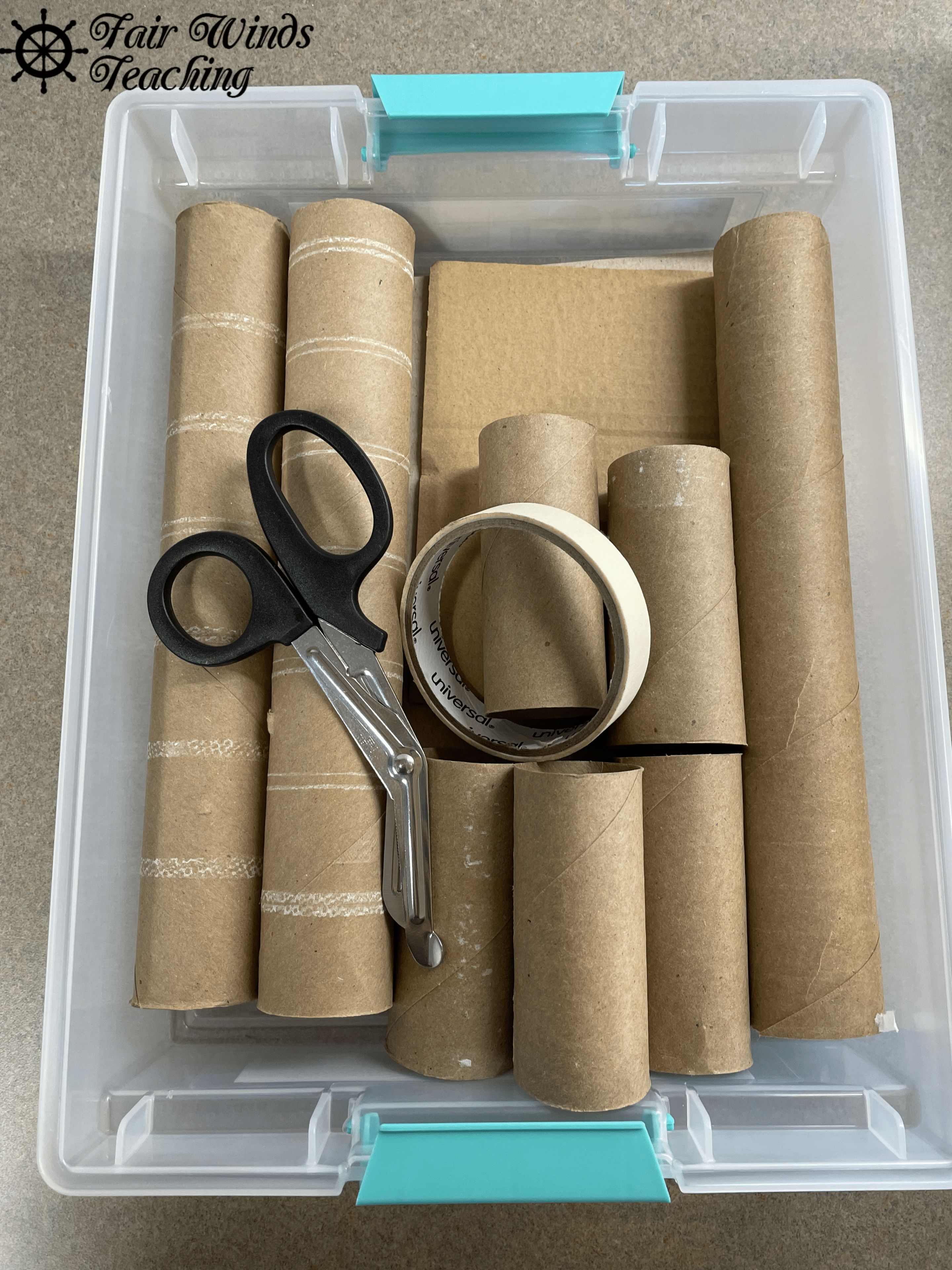
Here is the list of items I have in my classroom (and then some) you can find these quick links on my website:
|
Brain flakes
|
Ozobot coding robots
|
Playdoh clay
|
Lego blocks
|
Building discs
|
|
Digit builders
|
Picasso tiles
|
Pipe building
|
Straw constructor
|
Logic puzzles (Dollar Store)
|
|
Magnetic tiles
|
Logic teasers (Dollar Store)
|
Rubik’s cube
|
Blank Space Books (Fair Winds Teaching)
|
Coding mouse
|
|
Makers Mats (Brooke Brown)
|
Watercolor paints
|
Stickers
|
Fingerprint Art
|
STEAM Books
|
I also created these “Starting with STEAM” bin labels to add to your organized bins. I used label holders from the Target Dollar spot or found some online. Simply print and laminate for a quick and easy way to stick them on.
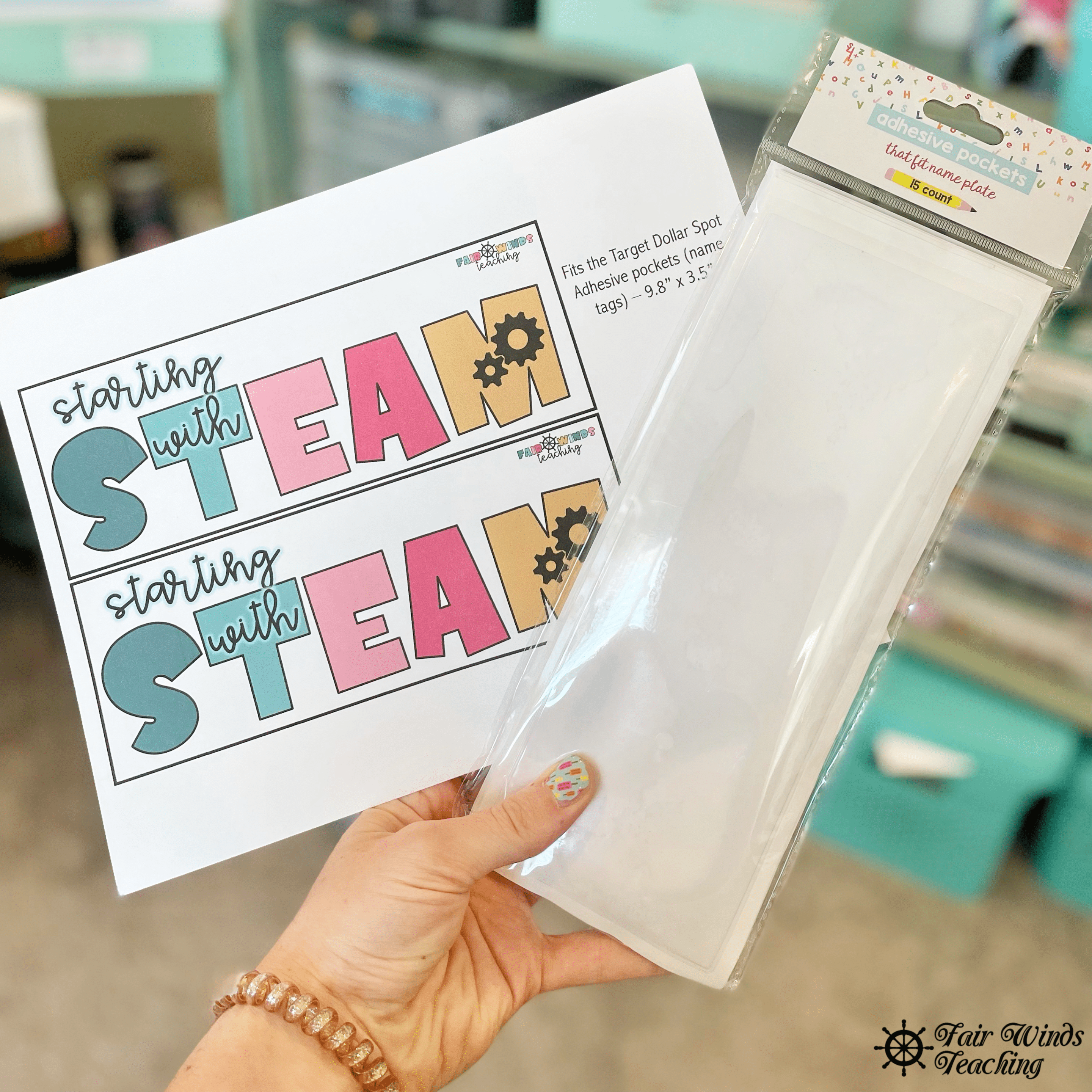

One of the student’s favorite Starting with STEAM bins to grab are my Blank Space Books. These books are a shared experience with their classmates. I bought colorful blank books from the Target dollar spot (or available online) and added these class Blank Space topics. The bundle has over 10 different book ideas. The students use the printed template to have lined paper to glue on or use the blank space the page provides. They write an experience for their other classmates to read. Then they also have the opportunity to read other students’ responses. It gives them an outlet to share a time they went on a vacation, lost their tooth, or got an ouchy.
There are plenty of pages for them to use to write and draw and then take some time to read other entries. When the book is complete, I add it to the book center and glue another topic label on another blank book. Grab these now for your Starting with STEAM bins or independent writing center.
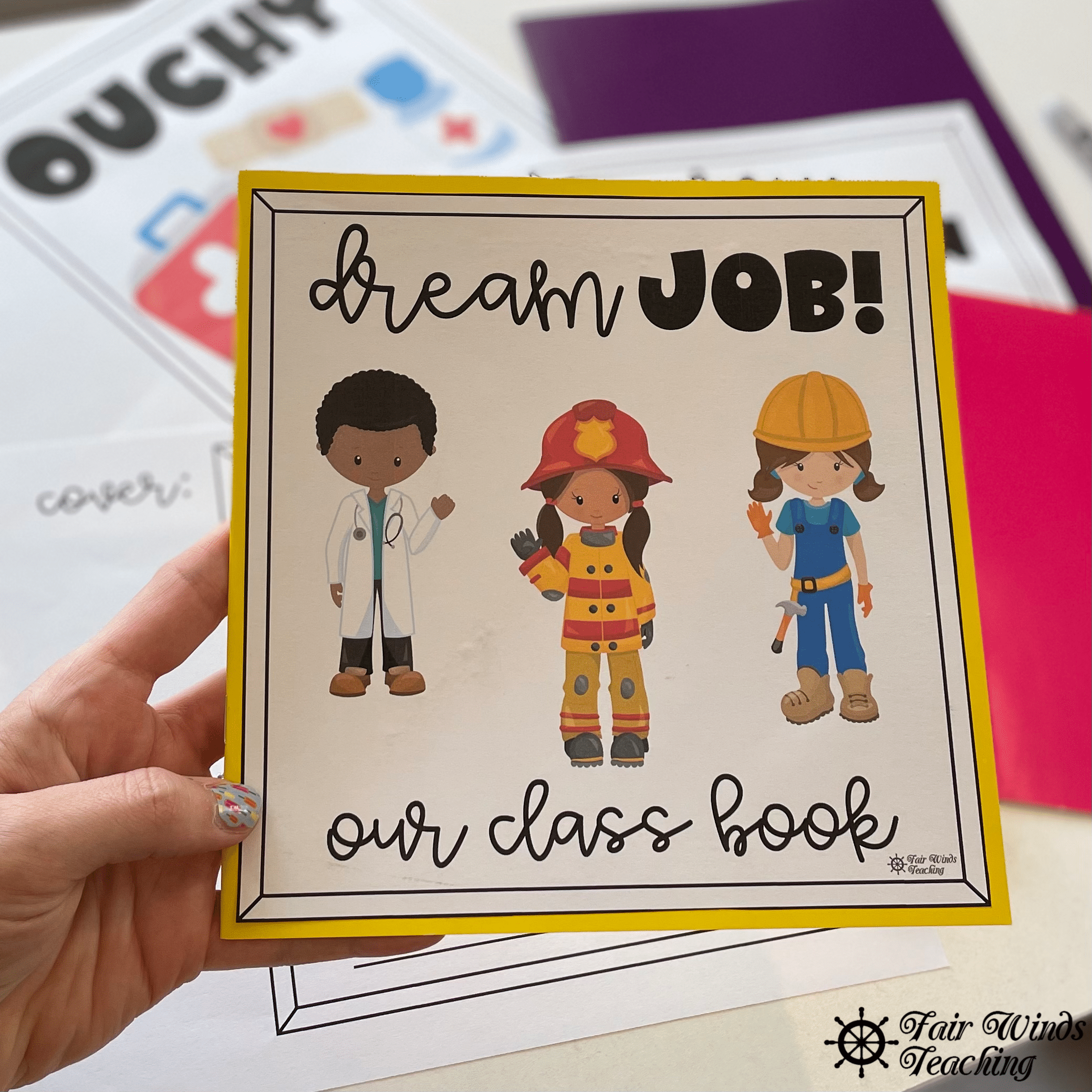
Lastly, I also want my students to read STEAM books. I use one of the containers of Starting with STEAM bins to add and change out a few of my favorite STEAM books. Check out my list of the Best Nine STEAM books for my classroom. These books help open the mind to a child who might be nervous to get creative or think outside the box.
My top favorite STEAM books for children:
-
- Rosie Revere Engineer by: Andrea Beaty
- The Day the Crayons Quit by Drew Daywalt
- Iggy Peck Architect by: Andrea Beaty
- Balloons Over Broadway by Melissa Sweet
- Perfect Square by Michael Hall
- The Most Magnificent Thing by: Ashley Spires
- What Do You Do with an Idea? by: Kobi Yamada
- If I Built a House by Chris Van Dusen
- What to do With a Box by Jane Yolen
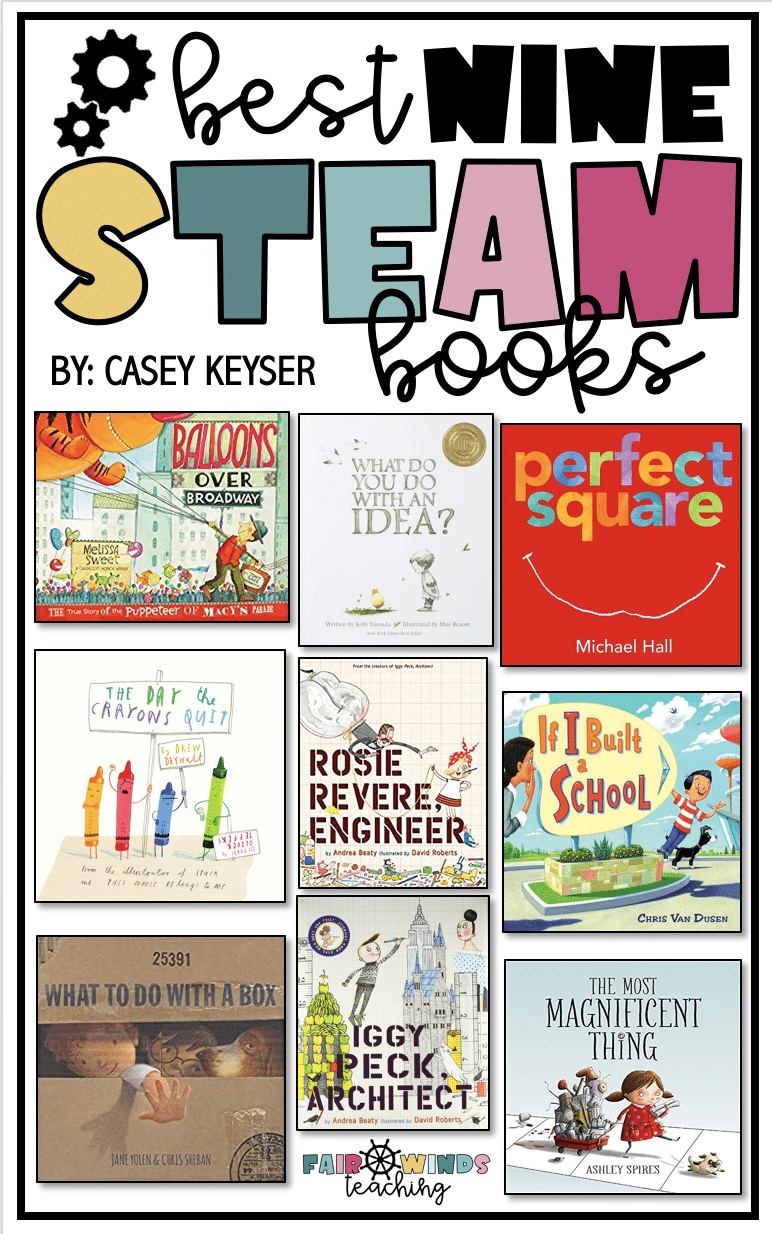

Casey Keyser is a third-grade teacher at Butterfly Ridge Elementary in Frederick County, Maryland. She was recently recognized as the national winner of the NEA Foundation’s 2021 Teaching in Excellence Award. Casey is the proud owner of the Education Resource Blog, Fair Winds Teaching, and loves to connect with her education community through her TeacherPayTeacher’s business.

by California Casualty | Nurses |
Long shifts, overnights, and demanding workloads are all a part of being a nurse. But no matter if you’re a 10-year veteran or just starting out, it’s never easy to miss the holidays because you have a shift.
Whether it’s a Thanksgiving or Christmas with the family, a romantic New Year’s Eve or Valentine’s dinner with your significant other, or a fun Memorial or Labor Day weekend away with your friends; missing out on celebrations is just another part of working in a career dedicated to service.
But you don’t always have to miss out on the fun. You do have some control over when you work and you can also find creative ways to celebrate! Here’s what you need to know when the next holiday rolls around.
The schedule gets decided early. Make adjustments in advance.
Holidays are often divided up early in the year. Sometimes hospitals or nursing facilities follow seniority when assigning holidays. Other times, they are divided evenly among the staff. You can volunteer to work holidays that aren’t as important to you to get off for others that are. Talk to your co-workers. Put in any requests for switches early on. You’ll have the best chance of a schedule adjustment if you make it weeks or months in advance of that 12-hour shift.
Prepare your family for your holiday work schedule.
You will likely hear loved ones complain that you are missing important family gatherings. Help your family understand how important your job is, and plan an alternative celebration. For example, you may not be able to join the family for Thanksgiving dinner but you could make it for a pre-Thanksgiving Wednesday night gathering or Black Friday shopping. Be part of the celebration any way you can. Ask them to save you some leftovers so you can enjoy that famous green bean casserole after the fact.
Restructure your holiday routine to minimize commitments.
Don’t offer to host the annual family holiday gathering or RSVP to many parties. Know that you have to work during the holidays and your free time is valuable. Scheduling too many commitments can easily cause you to burn out. Practice self-care during the holiday season. Do your best to reduce and relieve stress so that you will be there for your patients, your family, and most importantly, yourself.
Some holidays are busier than others at work. Prepare accordingly.
If you are an emergency nurse working a holiday like the 4th of July, prepare for an active night. Celebrations that include fireworks and sparklers could lead to injury. Also in July, you might experience the July effect, the time when new residents begin treating patients. As a nurse, you will want to support them to ensure there are no mistakes.
Expect senior leadership coverage to be lighter.
Most senior leaders will be at home, celebrating with their families on holidays. But they will be accessible. Make sure that you know how to reach them if there is a need.
It pays to work on holidays.
Many employers offer overtime or double time to work a holiday shift. Some also provide a free holiday meal. Enjoy those holiday perks and save that extra pay for something fun. You deserve it!
Technology can keep you connected.
If there is anything we learned from 2020, it’s how to celebrate holidays virtually. You can check in on your family celebrations while on your break via video chat or by sending photos back and forth.
Remember that you’re not the only one working the holiday.
Up to a quarter of all Americans work at least one holiday in the winter, according to the Daily Nurse. This includes your coworkers as well as restaurant staff, retail workers, police officers, and firefighters.
Your patients are also missing the celebration.
You can spread cheer with some holiday-themed scrubs and a conversation about your patients’ holiday traditions. Encourage families to bring in holiday decorations for their loved one’s room. If you have the time, help patients to video chat with their loved ones. It will make everyone feel great!
Just because you are working over the holidays doesn’t mean you can’t celebrate with your work-family. You have an automatic guestlist for any holiday gathering at work. Plan a pot luck dinner where everyone brings a favorite from their family’s Thanksgiving celebration. Arrange a Secret Santa gift exchange with your co-workers. Toast to a New Year together and share your resolutions. Deck out in red, white, and blue for the 4th of July. Decorate the nurses’ station, etc.
If you start to get down about missing another holiday – remember your “why.” “When a person decides to become a nurse, they make the most important decision of their lives. They choose to dedicate themselves to the care of others.” – Margaret Harvey
This article is furnished by California Casualty, providing auto and home insurance to educators, law enforcement officers, firefighters, and nurses. Get a quote at 1.866.704.8614 or www.calcas.com.

by California Casualty | Firefighters, Health |
The Fourth of July is a day of patriotism and pride. There’ll be BBQs, picnics, and parades all leading up to fireworks displays in towns and cities across the nation.
Family and friends will also gather for their own fireworks displays. While they can be beautiful and fun, safety groups warn to be safe when setting your own fireworks. All too many of us have known or heard about someone losing a finger, an eye, or suffering severe burns from an accident with one of these hot, exploding devices.
On average, more than 11,000 people are injured annually by fireworks. Young adults ages 20-24 are the most likely to be hurt, followed closely by children ages 5-9; most of the injuries occur on the hands and fingers, head, face and the eyes. Ouch! The National Fire Protection Association warns that even “kid friendly fireworks” like sparklers burn at 1,200 degrees – hotter than the temperatures that melt glass, plastics and some metals – inflicting terrible burns.
If you plan on setting off fireworks this year be safe and have fun! But always be sure to take the proper precautions so no one gets hurt. Follow these essential safety tips when you are shooting fireworks this weekend:
- Never allow small children to play with or ignite fireworks
- Only light fireworks one at a time, then move back quickly
- Never place any part of your body directly over a firework when lighting it’s fuse and back up a safe distance immediately after lighting
- Don’t try to re-light or pick up fireworks that have not ignited fully
- Never point or throw fireworks at another person
- Always keep a bucket of water or a garden hose handy in case of fire or other mishap
- After fireworks complete their burning, douse it with plenty of water before discarding to prevent a trash fire
Be sure to also protect your home as well! The NFPA also warns that more fires are reported on Independence Day than any other day of the year, and fireworks account for two-out-of-five of those fires.
Is your home protected? Contact a California Casualty advisor to get a quick policy review at 1.800.800.9410 or visit www.calcas.com.
This article is furnished by California Casualty, providing auto and home insurance to educators, law enforcement officers, firefighters, and nurses. Get a quote at 1.866.704.8614 or www.calcas.com.

by California Casualty | Travel |
Traveling can make money disappear fast – from flights to accommodations to activities, costs can add up quickly. But the good news is, they don’t have to!
We got some inside tips from the traveling pros on how you can save big and find the best deals the next time you travel.
Tip #1: Search airline deals for off-peak rates using anonymous browsers.
The most expensive flights occur when most people are traveling. Use that knowledge to book flights during times when airlines are less busy such as mid-week or outside tourist season.
Tip #2: Sign up for credit cards that give you travel points.
If you love to travel, consider a credit card that gives you travel points. Many frequent travelers use this system to earn free flights or stay for free in their destination of choice.
-
- You get bonuses from many cards just for signing up.
- Then you have to spend to accumulate more points. Consider using this credit card to pay your rent or mortgage, car payment or other larger monthly bills. It’s like using any other account, but with a travel bonus!
Tip #3: Choose a destination where your money is actually worth more.
When you’re considering where to travel, think about countries where the dollar is strong. That will make your money go further.
-
- You’ll find cheaper travel in Asia: Vietnam, Nepal, Thailand Laos, Indonesia Mexico, Colombia, Brazil, and Bolivia.
- You’ll also find great deals in and near Europe: Romania, Ukraine, Turkey, and Georgia.
- Some countries will even reimburse you for all or part of the retail sales tax that you spend there. These include Canada, Japan, Taiwan, and the United Kingdom. Keep your receipts and fill out the forms. You will need an official stamp by customs at the airport.
Tip #4: Be creative in your accommodation choice.
You can stay in a hotel and perhaps earn loyalty points. Or you can find some unusual local places simply by searching for alternative places to stay.
-
- Airbnb is one of the most well-known accommodation sites. But make sure you also have a look at its competitors: Tripping.com, HomeToGo.com, FlipKey.com, OneFineStay.com, Vrbo.com, HouseTrip.com, and Couchsurfing.com.
- Save money by staying in the lesser-known town close to where you want to be.
- Trade homes. Stay in a family’s home while they stay in yours. Check out sites like HomeExchange.com that matches you with your preferred destination.
- Check out housesitter.com to see if you can housesit in the place where you’d like to vacation. Then you’ll stay for free!
Tip #5: Go local for activities and meals and embrace the discounts.
You may want to hit the highlights of your destination’s tourist sites, but chances are the most memorable experiences will be the ones that you discovered while you were there. In planning your travel itinerary, here are some hints.
-
- Talk to locals and get their recommendations for things to do and places to eat.
- You can eat with local families via https://www.eatwith.com.
- Research the free or discounted days and times at museums and galleries, book standing-room-only tickets at shows, and ask about age-related, student, and group membership discounts.
- Take public transportation or walk rather than renting a car. You’ll see more and it will cost less. Consider a frequent travel card for public transport (Oyster card in London, Octopus in Hong Kong).
Tip #6: Avoid international roaming charges.
Your smartphone or laptop may work overseas but it could land you a huge bill for WiFi upon your return. Plus, the WiFi charges at hotels can come with extra charges. Take some steps to get inexpensive WiFi where you travel.
-
- Check with your smartphone provider about an international travel plan to see if it’s cost-effective. You can also ask them to unlock your phone so that you may insert a local SIM card while you’re in a new country.
- Rent a mobile router known as “pocket WiFi.” These hotspots are popular in Europe and Japan.
- Rent an international cell phone. But remember, if you use your phone as a camera, you’ll want to upload those photos to the cloud (or use your original phone or a real camera to take photos).
Enjoy the journey—and the savings. Stay safe and happy travels.
This article is furnished by California Casualty, providing auto and home insurance to educators, law enforcement officers, firefighters, and nurses. Get a quote at 1.866.704.8614 or www.calcas.com.



